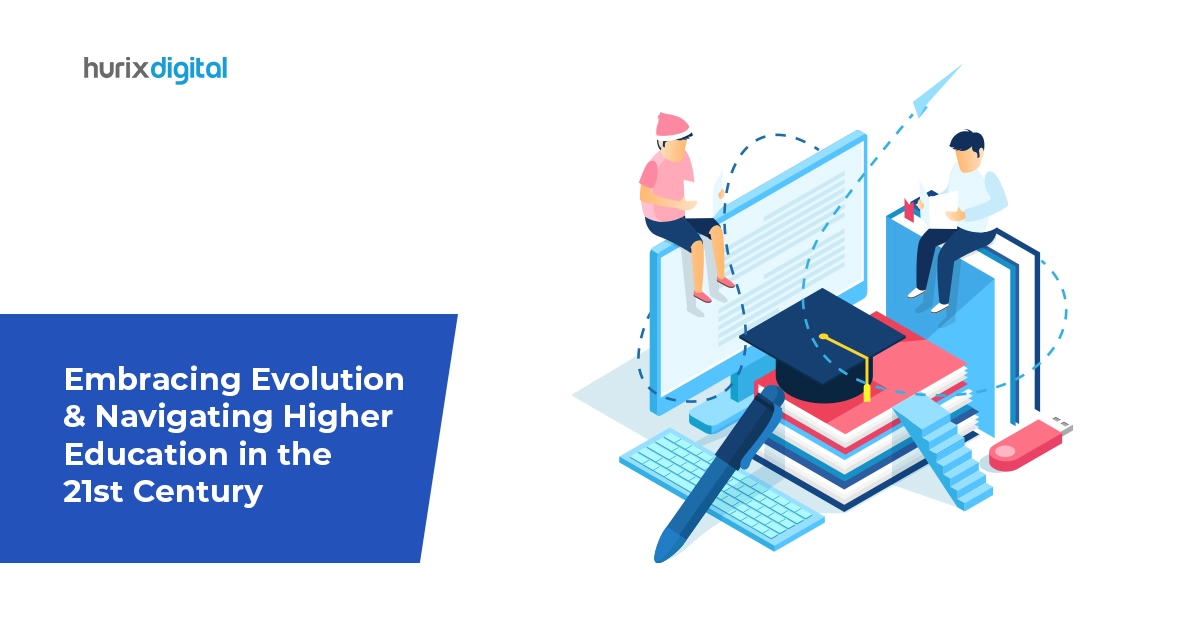
Embracing Evolution & Navigating Higher Education in the 21st Century
Summarize with:
With developments pulsing through the technology and business space, what learners are expected to have a grip or expertise on is evolving exponentially. The 21st Century has seen a dramatic change in education in terms of delivery and curriculum.
Considering that the eLearning and immersive education markets are already valued at 316.2 and 33.2 billion dollars, respectively, the potential to evolve with this changing tide is evident. Institutions and businesses must embrace higher education evolution to stay relevant and competitive.
To help you navigate this changing landscape, this article covers what elements give way to the evolution, trends rising to meet these goals, and a deep dive into the latest blended learning approaches and emerging developments in the educational space. Read on!
Table of Contents:
- Elements That Drive the Higher Education Evolution
- Rising Trends in Higher Education
- Three High-Impact Blended Learning Practices
- Where the Future of Higher Education Is Headed
- Paving the Way for Quality and Relevant Learning
Elements That Drive the Higher Education Evolution
Higher education has transformed through necessity and clear growth in learner goals.
Here are the four elements that drive the evolution of higher education in 2024:
1. Job Market Demands
Employers of today expect candidates to have a strong hold on problem-solving, digital literacy, and multidisciplinary skills. These expectations surpass the results from traditional curriculum models, compelling universities to develop flexible, holistic students ready for the rapidly changing workplace.
2. Demographic Shifts
The student body’s age range, backgrounds, and aspirations are expanding. This shift in the population necessitates more flexible and accessible educational options, such as part-time programs, online learning, and support services. Thus, learning modules that go beyond traditional classroom training are needed.
3. Personalization
Realizing their unique style and preferences, learners now expect educational experiences tailored to their individual needs and career aspirations.
This has led to the rise of adaptive learning technologies, personalized advising, and competency-based programs that allow students to progress at their own pace and focus on relevant skills.
4. Internationalization
The higher education curriculum has reached a global scale. With the internet connecting us on a personal and professional level, equipping ourselves with socio-cultural differences, global perspectives, and cross-border educational collaborations is now a real need to level the learning space.
These needs actively result in curriculum transformation and promote localization, cultural exchange, and even communication skills in the classroom.
Also Read: The Impact of Virtual and Augmented Reality on Higher Education
Rising Trends in Higher Education
Considering the elements of change, understanding the latest higher education trends that are having the most impact on learning growth, engagement, and retention levels is imperative to meet evolving needs and designing effective learning modules.
Here are five of the latest trends amidst the evolution of higher education, categorized by the approach:
1. Online Learning
With the rise of digital connectivity, online education has successfully delivered on all evolving learner goals and expectations. Effective online learning trends include self-faced digital courses, Massive Online Open Courses (MOOCs), micro-credentials, and even fully online degree programs.
2. AI-Powered Personalization
Artificial intelligence (AI) plays a vital role in higher education evolution. AI-powered adaptive learning platforms, personalized advising tools, and predictive analytics deliver content to match a learner’s growth, style, and specific areas of improvement.
This trend enables the live development of personalized modules in real time with data-driven insights, delivering huge advantages to individual student’s educational experiences.
3. Competency-Based Education
Another focus of higher education evolution is skill-based expertise. This means that performance is prioritized over the time spent on the learning module.
Competency-based education is a vital trend that focuses on learners demonstrating mastery of specific skills and competencies rather than accumulating credit hours. This allows for more personalized and self-paced learning.
4. Experiential Learning
While digital learning in higher education grows, another higher education trend is the increased emphasis on execution to prove conceptual skills in real-world settings.
Modules that incorporate immersive technology, such as Virtual Reality (VR) simulations or Augmented Reality (AR) modules that focus on allowing learners to interact and immerse themselves in the module to drive experience, are an integral part of higher education evolution as they develop practical skills and real-world problem-solving abilities.
5. Microlearning
The current educational landscape has increased the focus on time management and blending learning with execution.
Microlearning is a trend that effectively addresses this through bite-sized learning modules that deliver specific skills and knowledge in short bursts. This allows learners to quickly upskill or reskill in high-demand areas, fit learning into busy schedules without compromise, and boost their employability.
Three High-Impact Blended Learning Practices
With the vast potential of blended learning in mind, here are three blended learning approaches and practices that will elevate its overall impact in meeting the needs of higher education evolution:
1. Strategic Integration of Technology
Tech tools such as VR or AR are best implemented as supplements to in-person learning. This blended learning approach distributes equal focus to enhancing communication, collaboration, and access to resources as well as technological benefits such as digital literacy and immersive experiences.
2. Adopt Interactive Experiences
Another aspect that plays a vital part in higher education evolution is the interactive element. Here are some practices and approaches that adopt quality learning through interaction,
- Gamification through reward points and contests cultivates healthy competition, and leadership boards fuel positive mindsets toward the classroom element.
- Online video discussions and debates keep interactions collaborative and build on social skills such as etiquette, presentation, and public speaking.
These elements mitigate the distancing that may arise from online learning and bring the traditional learning approach of active collaborations into focus.
3. Flipped Classroom Model
This approach to blended learning primarily focuses on delivering learning content through self-paced online modules. Through this, the time in physical classrooms is dedicated to interactive activities, discussions, and applying concepts through projects and simulations.
Where the Future of Higher Education Is Headed
Higher education has not stopped evolving. With the constantly changing professional, aspirational, and educational landscape, the roadmap of higher education evolution promises progressive developments to meet growing needs and improve learning quality.
Apart from the approaches we’ve covered already, here are some of the developments and priorities that are on the horizon,
1. Accessible Design
Incorporating inclusivity in the future of higher education standards will be a high priority to level the learning opportunities. While online learning must already follow relevant WGAC guidelines as a legal mandate, the accessible design will be adopted into blended learning approaches to mitigate the barrier between learning with accessibility and without.
2. Global Virtual Campuses
As technology in higher education continues, every university and its campuses will be brought to the international level through global virtual campuses. These campuses will relieve all geographical barriers for students to learn and allow universities to filter lectures and staff without the burden of local time zone restrictions.
3. Blockchain for Security and Shareability
Blockchain is becoming the future of credentialing and content delivery. This will revolutionize how academic records are stored and verified, making them more secure, transparent, and portable across institutions and countries. It will also create tamper-proof assessments, elevating the credibility of online degrees and diplomas in the job market.
Also Read: Top 8 Proven Strategies to Drive Revenues of Higher Education Institutions
Paving the Way for Quality and Relevant Learning
As the professional and technological landscape evolves, higher education evolution is inevitable.
We’ve covered the drivers of this evolution, the rising trends, and key blended learning approaches that most impact meeting the latest needs and expectations.
At Hurix Digital, we understand the crucial role that adaptation and innovation play in the evolution of higher education. From personalized learning platforms to immersive educational experiences, we are committed to facilitating quality and relevant learning opportunities for learners worldwide.
Contact us now, and let’s get started!
Summarize with:

Senior Vice President
A Business Development professional with >20 years of experience with strong capability to sell new solutions and develop new markets from scratch. New Market Entry Specialist with experience working in the largest emerging markets. Exceptional experience in conceptualizing, ideating and selling new learning technologies like VR AR, etc. across multiple industry verticals.
 A Space for Thoughtful
A Space for Thoughtful 



